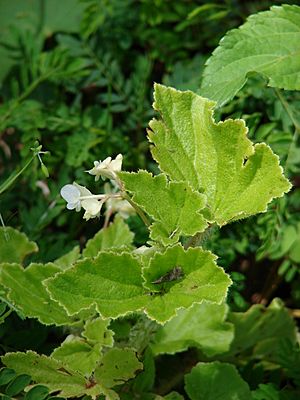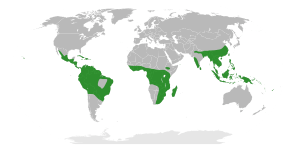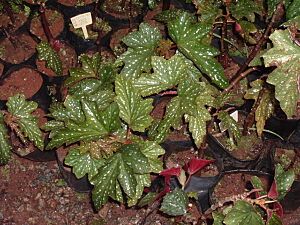Begoniaceae facts for kids
Quick facts for kids Begoniaceae |
|
|---|---|
 |
|
| Begonia hirtella | |
| Scientific classification |
|
| Kingdom: | Plantae |
| Clade: | Tracheophytes |
| Clade: | Angiosperms |
| Clade: | Eudicots |
| Clade: | Rosids |
| Order: | Cucurbitales |
| Family: | Begoniaceae C.Agardh |
| Genera | |
 |
|
| Range of the family Begoniaceae | |
The Begoniaceae are a family of flowering plants. This group includes about 1400 to 1500 different kinds of plants. You can find them in warm, wet areas around the world, both in the New World (like the Americas) and the Old World (like Africa and Asia).
Almost all of these plants belong to one large group called Begonia. There is only one other group in this family, called Hillebrandia. It has just one type of plant, and it grows only in the Hawaiian Islands.
Many different types of Begonia plants are grown for their beauty. People use them as ornamental plants in gardens and homes.
Contents
What are Begoniaceae Plants Like?
Plant Parts and Leaves
Most plants in the Begoniaceae family are perennial herbaceous plants. This means they live for more than two years and have soft, green stems. A few are shrubs, which are woody plants smaller than trees. They can be very small, just a few centimetres tall, or grow up to 3 metres high.
Their leaves and stems are often succulent. This means they are juicy and can store water, like a cactus.
The stems usually grow straight up. Many species also have rhizomes or tubers. These are thick, fleshy stems that grow underground. Sometimes, the main stem is very short, and all the leaves grow close to the soil.
The leaves of most Begoniaceae plants are simple and not divided into smaller parts. Their sides are often a bit uneven. In a few cases, the leaves are compound, meaning they are divided. Leaves usually grow alternately along the stem. If the stem is very short, all the leaves might grow in a cluster.
Flowers and Fruits
Most Begoniaceae plants are monoecious. This means they have both male and female flowers on the same plant. A small number are dioecious, which means a plant has only male flowers or only female flowers. The flowers usually grow together in groups called inflorescences.
The fruits of these plants are often capsules. These are simple, dry fruits that open to release seeds. Sometimes, the fruits are berries. All their fruits contain many tiny seeds.
Groups of Begoniaceae Plants
The Begoniaceae family was first named in the 1820s. It was officially named Begoniaceae in 1824 by a Swedish botanist named Carl Adolph Agardh.
There are two main genera (groups) in this plant family:
- Begonia: This is the largest group, with about 1400 different types of species. You can find them growing widely in tropical areas around the world.
- Hillebrandia: This group has only one species. It grows only in the Hawaiian Islands and is the only Begoniaceae plant native to those islands.
Another group from New Guinea called Symbegonia Warb. was recently added into the Begonia group.
Where Do Begoniaceae Plants Grow?
You can find plants from the Begoniaceae family in almost all moist tropical countries. They are not found in the tropical forests of Australia.
One special type, B. grandis, can even grow in cooler places. It grows as far north as near Beijing in China, which is a temperate zone.
How Are Begoniaceae Plants Used?
Many types of Begonia plants, including different varieties and hybrids, are popular around the world. People use them as ornamental plants because they have beautiful leaves and flowers. You can see them in parks, gardens, on balconies, and even as houseplants inside homes.
Images for kids
-
Begonia flowers
See also
 In Spanish: Begoniaceae para niños
In Spanish: Begoniaceae para niños








